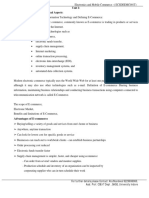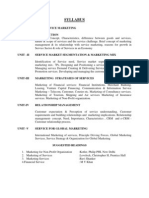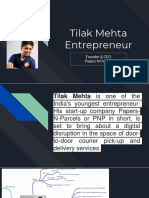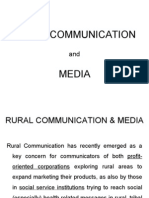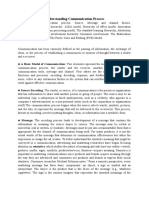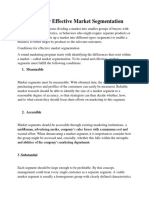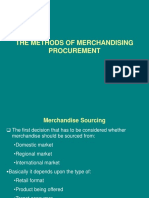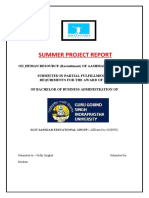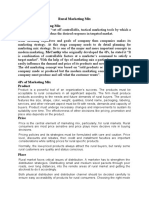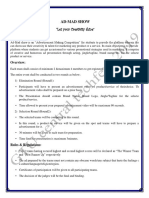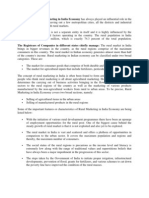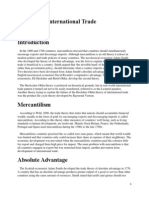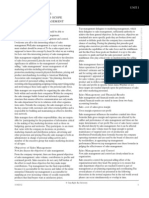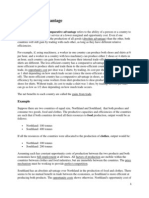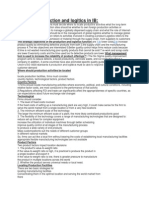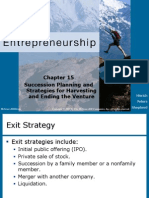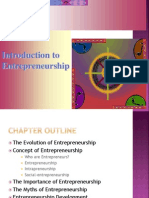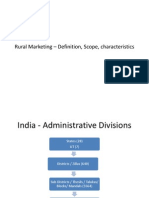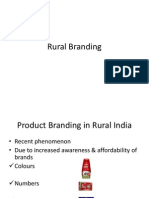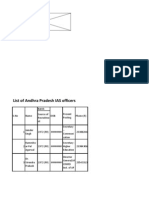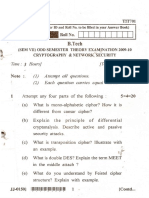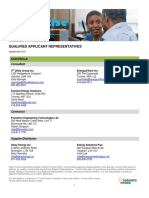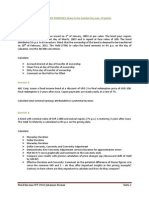RURAL MARKETING
Taxonomy, Changing Patterns, Attractiveness, Constraints
�Taxonomy
Consumer Markets Industrial Markets Service Markets
FMCGs, Durables Seeds,Fertilizers,Pesticides,Tractors,Farm implements
Repairs,banking,communication,entertainment
�Map The 7 Os To Each Market
Who constitutes the Market? OCCUPANTS
What does the market buy? OBJECTS Why does the market buy? OBJECTIVES
Who participates in the buying? ORGANIZATIONS
How does the market buy? OPERATION When does the market buy? OCCASION
Where does the market buy? OUTLETS
�Changing Patterns
Rural Share 1989-90 1992-93 1998-99 2004-2005
Over 75%
Radio/ Transistors
Bicycle. Radio/Transistors
Bicycle. Radio/Transistors, Mechanical Wrist Watch, B&W TV
Bicycle. Radio/Transistors, Mechanical Wrist Watch, B&W TV, Pressure Cooker, Cassette Recorder Table Fan, Ceiling Fan, Sewing Machine, Motor Cycle, Quartz Wrist Watch, Moped
50-75%
Bicycle, Motor Cycle, Table Fan, Sewing Mechanical Wrist Watch
Table Fan, Sewing Machine, Mechanical Wrist Watch
Cassette Recorder, Pressure Cooker, Table Fan, Ceiling Fan, Sewing Machine, Motor Cycle, Quartz Wrist Watch Moped, CTV, Mixer/Grinder, Scooter, Electric Iron
30-50%
7
20-30% 10-20% 5-10% Below 5%
Moped, B&W TV, Cassette Recorder, Pressure Cooker, Electric Iron, Ceiling Fan, Quartz Wrist Watch Scooter, Mixer/Grinder CTV, Refrigerator Washing Machine VCR/VCP
Moped, Motor Cycle, B&W TV, Cassette Recorder, Pressure Cooker, Electric Iron, Ceiling Fan Scooter, Mixer/Grinder Refrigerator VCR/VCP, Washing Machine -
CTV, Mixer/Grinder, Scooter, Electric Iron
4
Refrigerator VCR/VCP, Washing Machine -
2 2 1 1
2 1 2 0
1 2 0 0
Refrigerator VCR/VCP, Washing Machine -
1 2 0 0
�Income distribution (Million population)
400
312 300 200 100 0 Low Rural Low er middle Middle high Urban 90 41 288
400
352
305
2001-02
130 153
300 200 100 0
2009-10
170 79 17
272
2001-02
Low Rural Low er middle Middle high Urban
�Attractiveness of Rural Markets
Urban push
Saturation Competition Changing lifestyles
Rural pull
Rising affordability Growing acceptability Increasing demand Improving accessibility Success stories
�CONTRIBUTING FACTORS
Agriculture Consistent good monsoons Better procurement prices fixed for various crops Better yields due to many research programs (HYV seeds provided by the government) Tax structures Spread of education Improved infrastructure Better banking facilities Government schemes like IRDP, JRY, NREGA Increased expenditure in plan outlay (from Rs.14000 Cr in 7th plan to Rs.30000 Cr in 8 th plan)
� Increased penetration of electronic media
� Life style changes
50 % of todays rural income is not from the agriculture sector coming
Up gradation from local products to branded and from low priced bands to premium brands Increasing influence of the youth in the buying decisions.
�HURDLES IN RURAL MARKETING
High distribution costs Large no. of daily wage earners Acute dependence on the vagaries of the monsoons Seasonal consumption linked to harvest and festivals Inaccessibility to conventional advertising media Poor roads, power quality Banking and credit issues High initial market development expenditure Wholesaler and dealer network issues Highly dispersed and thinly populated markets Social and cultural backwardness of the rural masses. Low level of exposure to different product categories and product brands.
�MAJOR CHALLENGES
I. AVAILABLITY
India's 6,38,365 villages are spread over 3.2 mn. sq. kms. 720 mn people - reaching them is not easy Given the poor state of roads, even greater challenge.
�Companies like HLL have made strong distribution networks. To service remote villages stockiest use rickshaws, carts and even boats in the back waters of Kerala.
�II.
AFFORDABLITY
Products need to be affordable to rural consumers ,most
of them are on daily wages.
Some companies have addressed the affordability problem by introducing small unit packs :
GODREJ introduced Cinthol and Fairglow in 50 gram packs priced at Rs.4
coca-cola
introduced Sunfill ( a powdered soft drink concentrate ) 25 gram pack priced at Rs. 2
�III. ACCEPTABLITY To gain acceptability for the product or service, there is a need to offer products that suit the rural markets and conditions.
coca-cola is providing low cost iceboxes because of the lack of electricity and refrigerators in the rural areas.
�IV. AWARENESS
With large parts of rural India inaccessible to conventional advertising media, building awareness is another challenge.
Companies like HLL use posters, banners and wall paintings to create awareness.
�SOME SUCCESSFUL APPROACHES
�Being first on the shelf
The retailers generally stock a single brand in a product category.
�Different means of advertising
Haats and melas
A survey by MART (Marketing and ResearchTeam) revealed that 47000 haats and 25000 melas take place every year in India Large visitor turnout These melas are held during post harvest season, when the purchasing power of the people is high The companies provide touch and feel demonstrations and distributed free samples
��Advertising
Performing arts including theatre, songs, dance puppetry, magic shows
�Rural Markets advertising points
�CAVIN CARE
First to come out with the concept of sachets and it revolutionized the whole market, making the Chic shampoo the 2nd largest selling shampoo in India What followed was the flood of products in small packing ranging from toothpaste, face creams, soaps, hair oil
�NIRMA
Introduced the innovative technique of using video vans for marketing Nirma products . Reach to interior areas Offer opportunity for personal interaction .
�LG
The company needed new cheaper products to capture the rural markets . The company did this by introducing a cheaper range of TV's by the name of Sampoorna. More offices in small towns. The company opened 178 branch offices in a short period of time
�COCA-COLA
1. Increase in number of outlets from 80,000 in 2001 to 190,000 in 2005 resulting in increased market penetration from 13 % to 28 %.
�2. It also tapped local available opportunities provided by annual haats and fairs and made huge investment in infrastructure for distribution and marketing.
�3. It brought down the average price of its products from Rs.10 to Rs.5,therby bridging the gap between soft drinks and other local options like tea, buttermilk or lemon water.
4. It doubled the spend on Doordarshan
�5. It focused its entire advertising towards the rural customer.
As a result the rural market accounts for 80 % of the new coke drinkers and 30% of its total volumes.
�ITCs e - CHAUPAL
The companys e-chaupal initiative is a novel idea which bypasses the brokers between the Company and the farmers. It is helping Indian agriculture to enhance its competitiveness by empowering Indian farmers through the power of the internet
� Formed in 1946,it is a brand name managed by an apex cooperative organization ,Gujarat Cooperative Milk Marketing Federation Limited which today is jointly owned by some 2.41 million milk producers in Gujarat. Has established itself as a uniquely appropriate model for rural development.
��HLL has played a dominant role in exploring the potential of rural India with its various projects
1. PROJECT STREAMLINE 2. PROJECT BHARAT 3. PROJECT SHAKTI
�Hindusthan Lever Limited
William Hasketh Lever 1885 Sunlight laundry soap in India 1888 (1757 EIC, 1858 British Raj) Merged with Margariene Unie of Netherlands (vanaspathi) to form Unilever Ltd UK 1930 Formed Hindustan Manufacturing Co for production of edible oil (1932 75% of 6000 MT edible oil market) Lever Brothers India Pvt Ltd 1933 United Traders for import & distribution of toilet products 1935 Three companies merged to form HLL 1956 (10% public)
�Launching of Brands & Rural Base
Late 1950s modernization of factories Purchased vanaspathi units Trichy (TN), Shamnagar & Gaziabad (Delhi) Vanaspathi 3,36,000 MT Lux 1961 Anik 1961 Sunsilk -1964 Rin 1969 Clinic 1971 Liril 1974 Close Up 1975 Late 1970s set up 70 medium & small-scale factories in rural areas
�Diversification & Expansion
Chemical plants at Haldi (Calcutta), Taloja (Maha), Jammu (J & K) FERA NRI 51% - 1980 Followed Govt regulation 10% exports, 60% priority sectors New synthetic detergent plant 1983 (Chindwara, MP) Agri Products 1985 (Hydrabad) Lifebuoy Personal, Breeze 1987 Colaboration with National Starch Corp,USA Pondicherry 1988 Synthetic detergent plant, toilet soap plant Sumerpur & Orai (UP) 1989 Lifebuoy Plus, Le Sancy 1991 Pepsodent, Methadent G 1992 Tomco, Kwality, Kissan, Lakhme (1992-1996) 50:50 JV Kimberly Clarke USA diapers, sanitary napkins late 1990s JV S C Johnson & Co USA pest repellents & disinfectants
�Indias Leading FMCG company
62% market share FMCG 1998 10 new factories packaged tea, personal products & detergents Focused on 30 power brands out of 110 brands 2001 Rs.1100 Cr T/o with PAT Rs.154 Cr. Today 12,000 Cr with 50% from rural markets
�HLLs Distribution Channel
Wholesalers & retailers Stock transfer through vans Redistribution stockists in towns who carried bulk stocks & serviced retailers 7000 redistributors who serviced over a million retailers
�Rural Focus
Sales, marketing & production of Power Brands in rural areas Key issues to be addressed availability, awareness, overcoming attitudes & habits, penetrative pricing Target of 16 million new rural households by 1999
�Project Streamline (1998)
Rural distribution issues Increase rural retail outlets from 50,000 (1998) to 100,000 (1999) Selected places with poor base, and no distribution facilities at all Rural distributor with 15 to 20 sub-stockists in villages who drove distribution in villages through unconventional means (bullock cart) Offered better service frequency, full line availability and credit Reach in rural markets increased from 25% to 37%
�Project Bharat (1999)
Direct marketing Address awareness, attitudes and habits of rural customers Home-to-home operations in districts with best potential to attract new users HLL Vans visited villages and sold Rs.15 small packs of detergent, toothpaste, face cream, talcum Taught how to use products with video Educated about superior benefits over current habits Awareness of product category, and availability of affordable packs Integrated Rural Promotion Van in villages with population above 2000 NGOs & UNDP for health & hygeine programs 1999. (2,35,000 from 85,000, covering 75% from 43%) Primary education through V-Sat
�Project Bharat ..cont
Villages with population less than 2000 Self employment through self help groups Direct-to-home distributors Less than Rs. 750 15 20 villagers Micro-credit from banks By 1999, covered 13 million households Shampoo 5% U - 16%R Skin care 8% U 14% R
�Project Shakthi (2001)
A.P 6 months Sustainable relationship HLL & low income customers Access to micro-credit Invest as company distributors Profit sharing for growth SHGs, NGOs, Govt. bodies to train March 2002 (6 months) 20% increse in sales Guj, MS, MP










